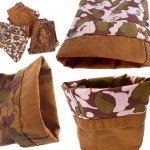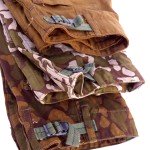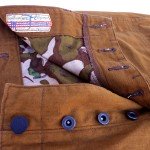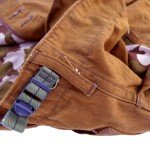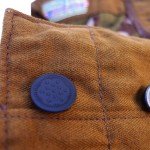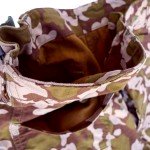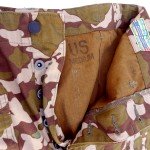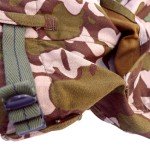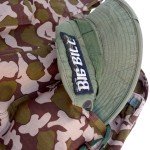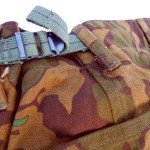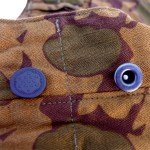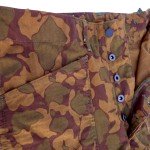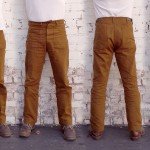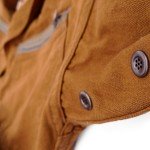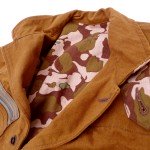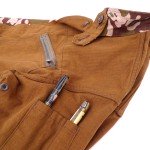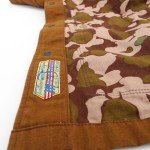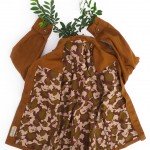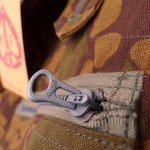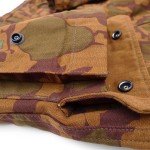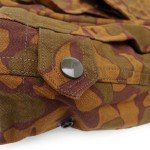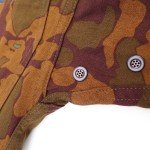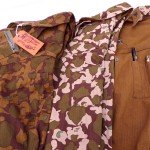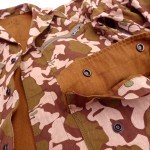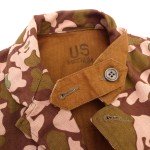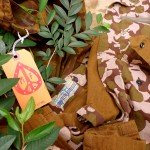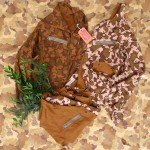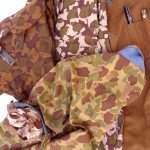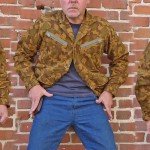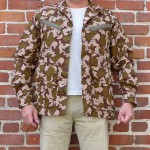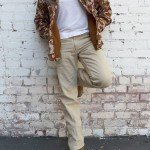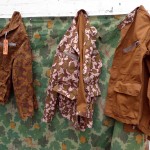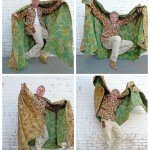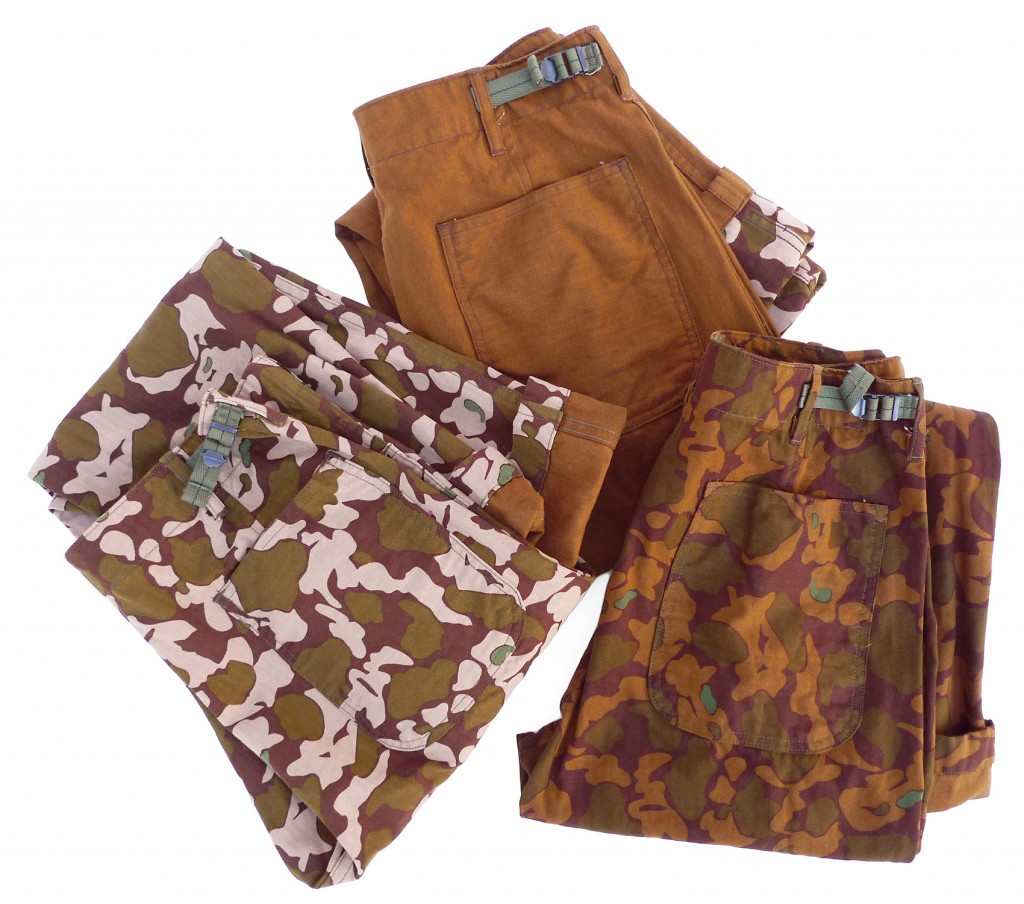
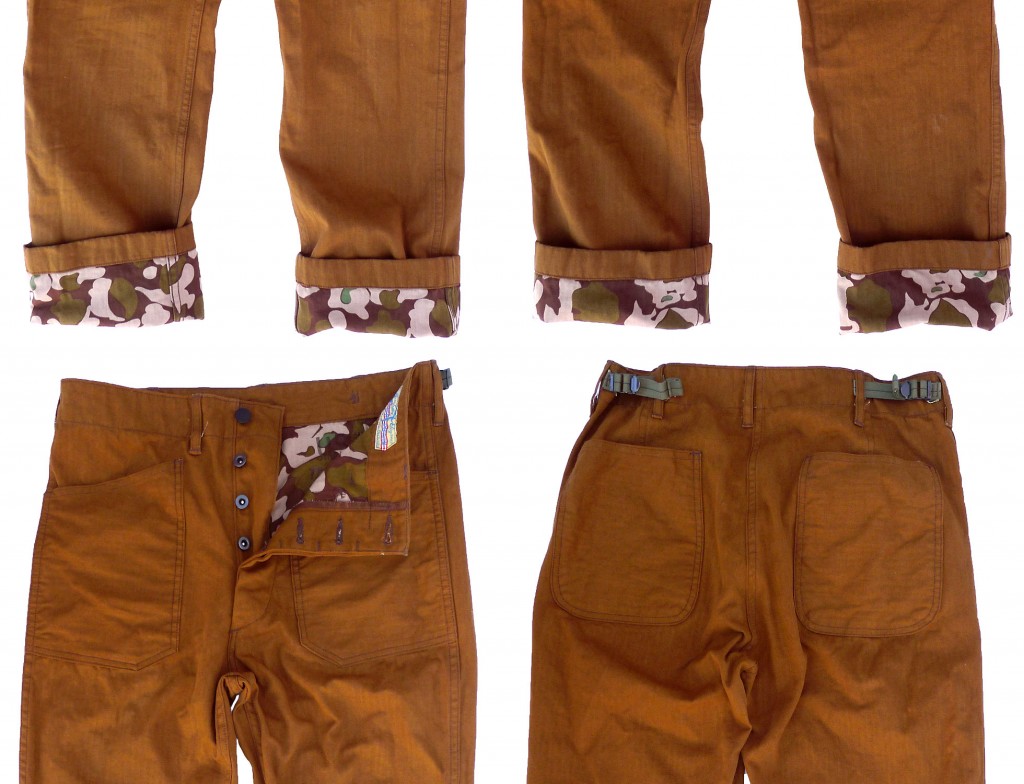 Utes Cachou.
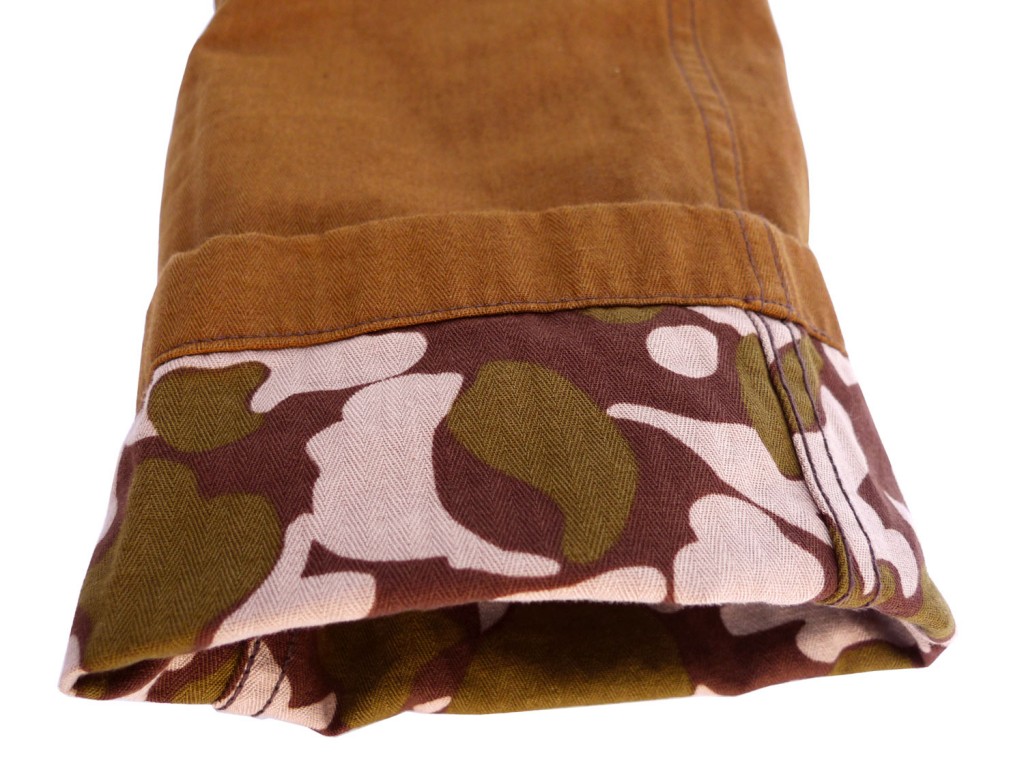
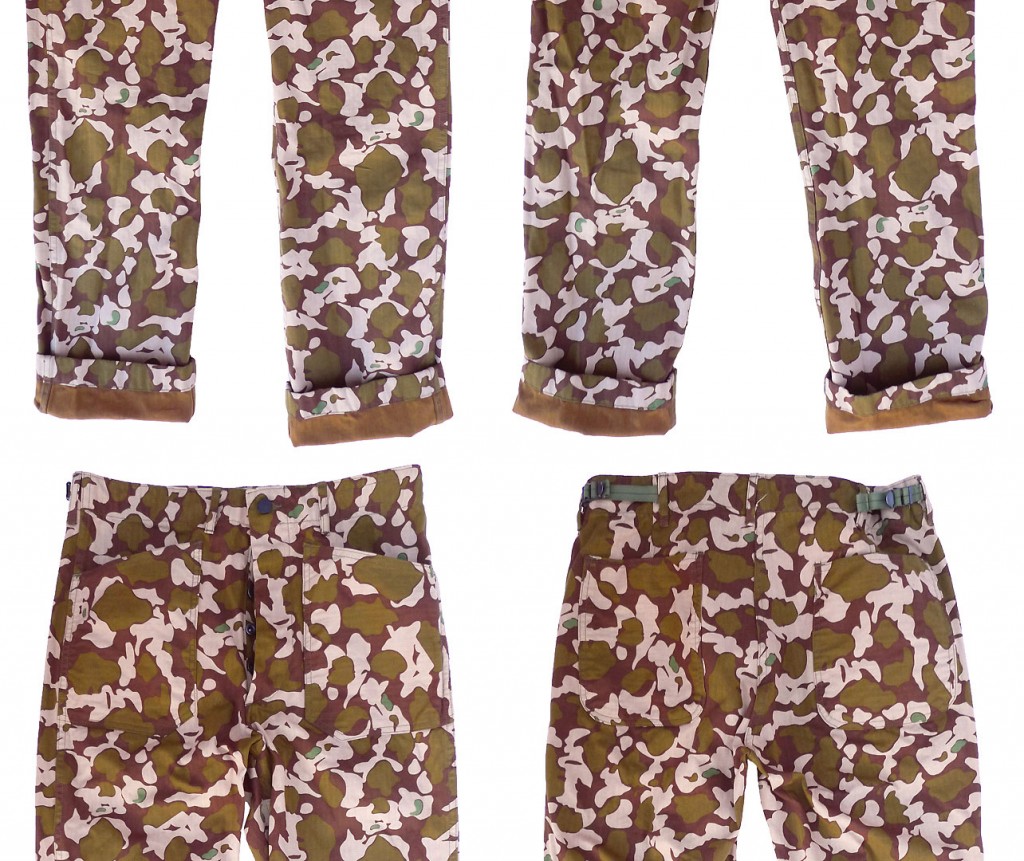 Utes Hiland.

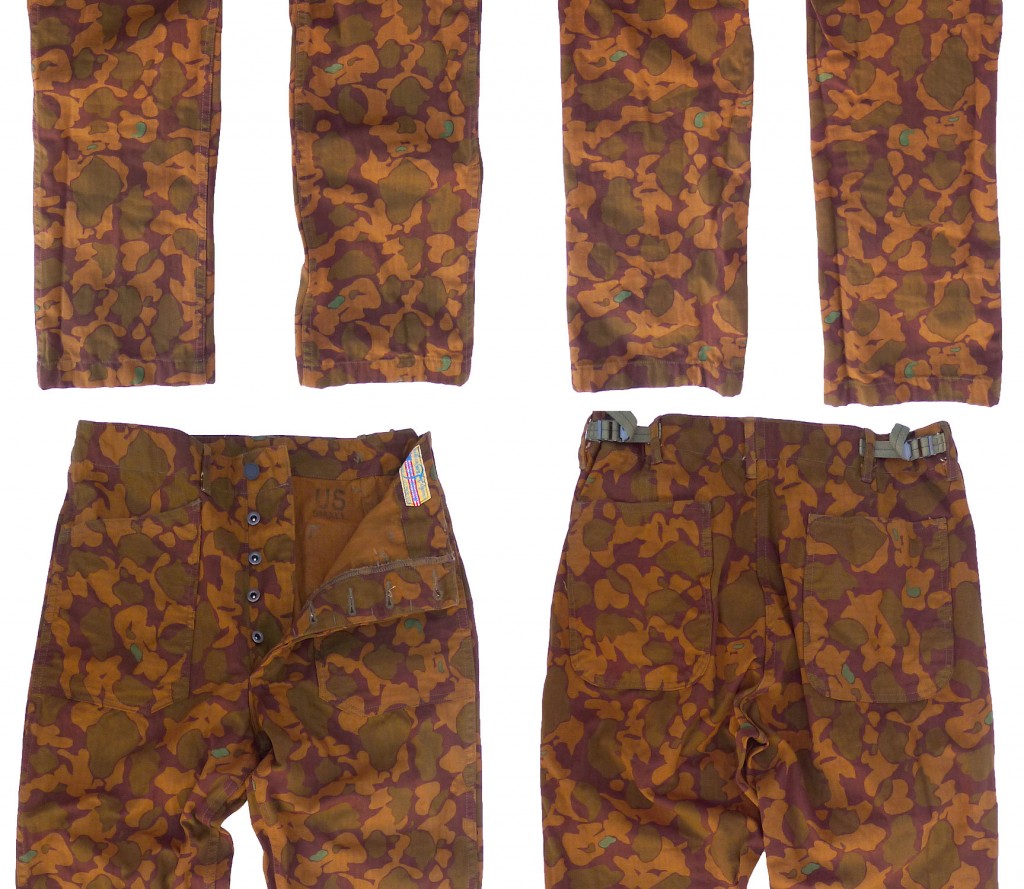 Utes Loland.
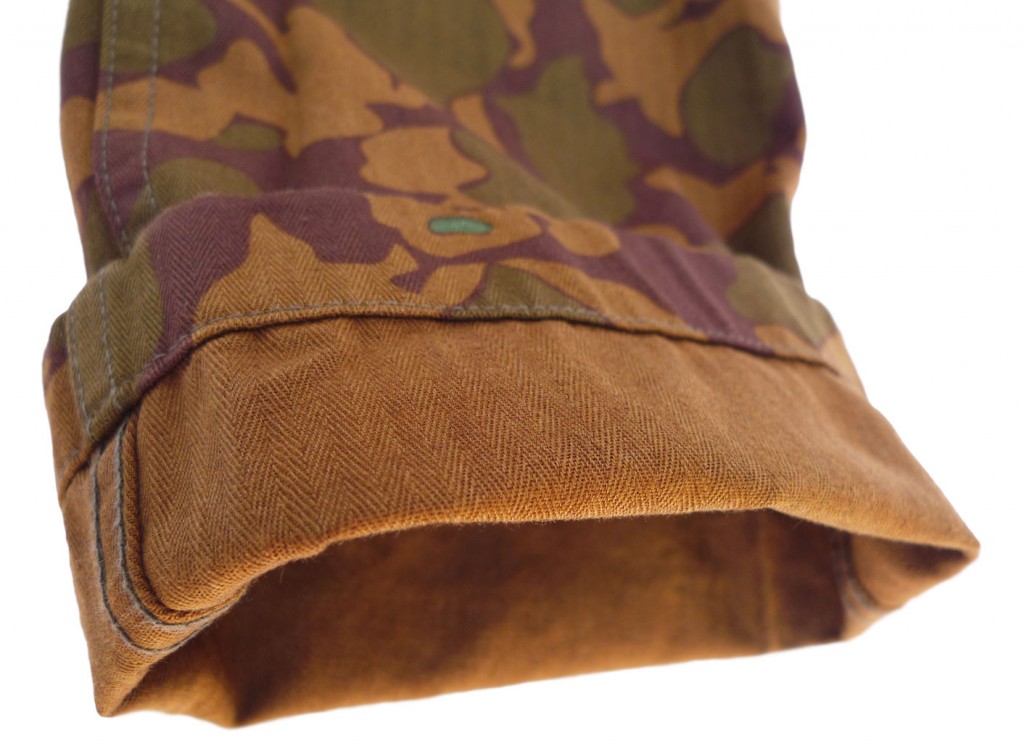
Utility Trousers, “Utes” Experimental Camouflage
Mister Freedom® “Saigon Cowboy” Spring 2015
For those into the jungle tuxedo, our MF® Experimental Camo is now available in fine looking trousers as well! For those lucky to have missed it, the account of how our original camouflage pattern came to be was summed up in the Evac Jak spiel.
For today’s story, who needs fiction when you have CIA declassified intel? Here is some of it, revisited…
The year is 1961.
American taxpayers have been unknowingly forking over $400 million to the French imperialist war effort in Indochina from 1945 to 1954 (thereby funding about 80% of the French Guerre d’Indochine), but we are still four years short of the ‘official’ engagement of the United States in Vietnam’s affairs of 1965.
In those years, some felt that if you didn’t stop the red devils (‘commies’) in the jungles of South East Asia, “they would have to be stopped in Honolulu or on the beaches of California.”
President Kennedy, a man of his times and a believer in the efficiency of US Special Forces guerilla tactics, sends 400 tiger stripes-clad intensively trained men to the highlands of South Vietnam in May 1961, in an effort to contain the spread of the National Liberation Front (NLF), China’s protégé…
Men in green berets immerse in the local culture, assess the situation and organize local resistance. Montagnards and local villagers receive training in jungle warfare. The enemy du jour? The Việt Cộng (Vietnamese Communists) guerrillas, VC (NATO’s Victor Charlie), or Charlie as often referred to by US boots on the ground.
A program called CIDG (Civilian Irregular Defense Group) and originally designed by the CIA has the task to assist in the transformation of local minorities into anti-communist paramilitary forces.
To more efficiently handle logistics, the highly-classified Counter Insurgency Support Office is established on the island of Okinawa, Japan in 1963. Headed by a mysterious individual working for the Department of Army by the name of Conrad Benjamin Baker, CISO was “assigned the mission of supporting the Special Forces programs through triservice depots and local procurement sources (…) Many items of clothing and equipment, for example, had to be obtained from markets in other countries because of size problems, composition of material, and equipment which had to be tailored to Montagnard measurements.” (source)
CISO acquired or produced ‘sterile’ (untraceable if captured) weapons, along with unmarked clothing and equipment to outfit US Special Forces or advisors heading out to South Vietnam. Locally screen-printed tiger stripe camo fatigues, “bowie” knives, VC-style black pajamas, rations, machetes, Seiko watches for recon teams, black 1-0 rain jackets, North Vietnamese Army-inspired rucksacks…
Basically, if it proved needed in the field, CISO sourced it out in Asia, or designed it and manufactured it locally. At a fraction of the price compared to US-made mil-specs issued gear, and quicker delivery than its state-side bureaucracy-laden official channel alternative. What exactly went on is not well documented, but Ben Baker’s account of his involvement in the original design and R&D of the famous SOG knife is available for download in pdf form here.
Note:
I am no expert on the topic and more accurate facts are available to those interested in History preservation willing to do the research. The “SOG” book by John L. Plaster probably answers many questions, but I admit having only flipped through its photo album companion (ISBN 1-58160-058-5) due to time restriction.
-
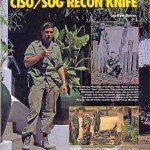
-
Courtesy of “Fighting Knives” magazine (1991)
-

-
1-0 CISO Jacket (Courtesy Jim Brzozkiewicz)
-

-
3rd Force Recon Patrol (Courtesy Doc Cassidy)
-
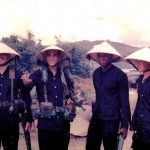
-
LRRPS (Photo Albert R. Brown 1968) Courtesy www.lrrpranger.org/
-

-
Montagnard in training (1962)
-
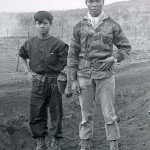
-
Montagnard Civilian Irregular Defense Group force attached to Company D MIKE-FORCE in the Dak To SF Camp fire-base
-
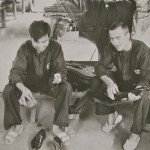
-
Special Forces Lt. Rich Entlich (1966) Courtesy Charlotte Sun newspaper
-
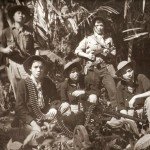
-
VC Guerrillas South Vietnam (1968)
-
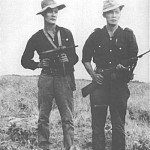
-
The feared “Men in black pajamas” (NVA photo 1968)
(Above photos credited to the best of our knowledge and provided for educational purposes only.)
I had found the logistics side of this CISO story quite fascinating when originally coming across it. As usual, we didn’t take any of this literally in our ‘Saigon Cowboy‘ venture. Imagination took over authenticity. We didn’t go black pajamas, decided to improvise instead, mixing things up into a somewhat plausible garment. Or maybe our ‘utes’ are just a pretext for sharing a slice of ‘behind-the-scene’ History…
The pattern for the featured MF® trousers this season blends details of US Navy dungarees, Army chino trousers, M-51 field trousers, Marine Corps M1941 trousers… a joint operation if you will.
The term ‘utes’ was lifted from the old USMC expression “boots ‘n’ utes” (boots and utility uniform).
As mentioned with the Evac Jak, the MF® Exp. camo combines camouflage with a simple solid side. The solid side cachou color is a reference to the caramel-like color typical of 1930’s French military canvas gear. Although this fabric is designed to be reversible, the trousers are not. Three options are available for the Exp camo utilities:
a) Cachou out/HiLand in.
b) HiLand out (arid terrain, lighter)/cachou in.
c) LoLand out (jungle, darker)/cachou in.
The sizing S,M,L,XL applied to trousers is a nod to old military field pants featuring cinch tabs. Those are often tagged with a ‘size range’ as opposed to a precise measurement, reflecting the waist-adjusting pull tabs.
The “US” stamp stands for sizing following American standards, as opposed to the “A” stamp differentiating Asian standards garments with CISO-issued gear.
Our ‘utes’ have a slimmer silhouette than typical standard-issue cargo pocket camo utilities, a reference to a silhouette favored by ARVN troops of the period.
The “Utes” are designed in California by Mister Freedom® and manufactured in Japan by Sugar Cane Co.
SPECS
FABRIC:
Somewhat of an original Mister Freedom® camo pattern, double-side rotary screen printed (one side solid, one side camo), white 100% cotton Herringbone Twill (HBT) fabric base.
Fabric milled and printed in Japan.
DETAILS:
* Inspired by vintage military utility trousers.
* Slimmer ‘ARVN’-type silhouette.
* Mid-high waisted.
* Front patch pockets locked in side seam, rear patch pockets, horizontal HBT.
* Side cinch tabs, mil-spec slide buckle.
* Flat black-painted Metal “13 Stars” tack waist button.
* Oxidized black donut-type fly buttons.
* Flat felled seams, chainstitch.
* 100% cotton tonal stitching.
* Made in Japan.
SIZING/FIT
This garment comes raw/unwashed and will shrink to tagged size after an original cold soak/line dry. Further shrinkage to be expected with the use of hot water and heat dryer.
All three MF® Exp. Camo fabric options will shrink the same.
I decided to size down in those, as I had done with the Crew Pants of the Sea Hunt spring 2013 collection, and I am wearing a Small (30). When both fully cinched, the waist tabs can tighten the fit by about 2 inches, but a Medium looked too baggy on me. A tagged Small technically corresponds to a 30-32 inch waist.
Please refer to sizing chart for measurements reflecting a 30mn cold soak no agitation/light machine dry.
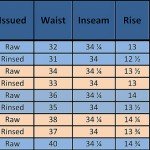
CARE:
Launder when hygiene dictates and common sense prevails.
Machine wash. Cold water, gentle cycle, eco-friendly mild detergent and line dry. We recommend turning garments inside out to avoid marbling of the fabric during the washing cycles.
Because the base HBT fabric is white before being printed, toning down of colors will naturally occur. This fading should not be considered a quest nor a defect, only the natural consequence of the wash/wear process over the years.
Available RAW/unwashed
SIZES:
Small (30)
Medium (32)
Large (34)
X-Large (36)
XX-Large (38)
RETAIL $229.95
Available from www.misterfreedom.com, fine retailers around the World, and our dusty Los Angeles brick & mortar store.
Email sales@misterfreedom.com or call 323-653-2014 with any questions unanswered above.
Thank you for your support

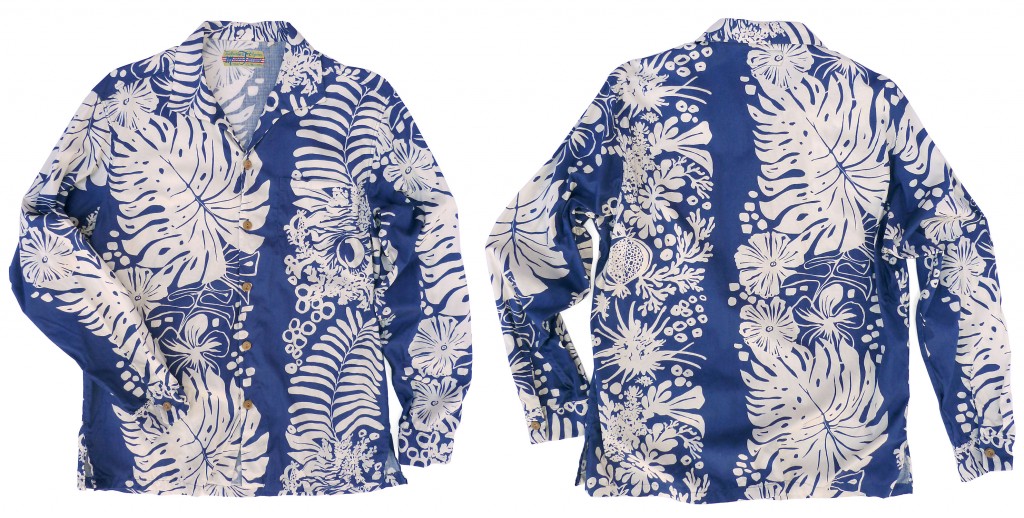
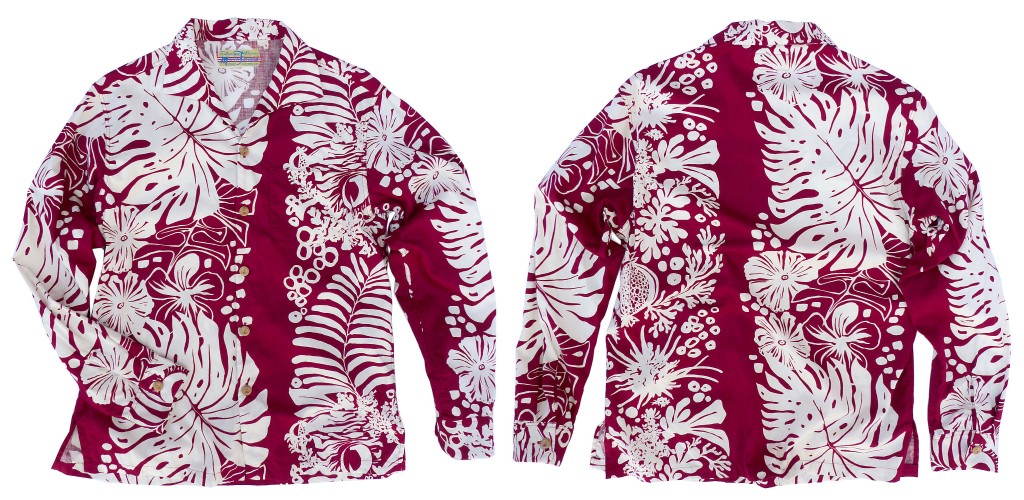
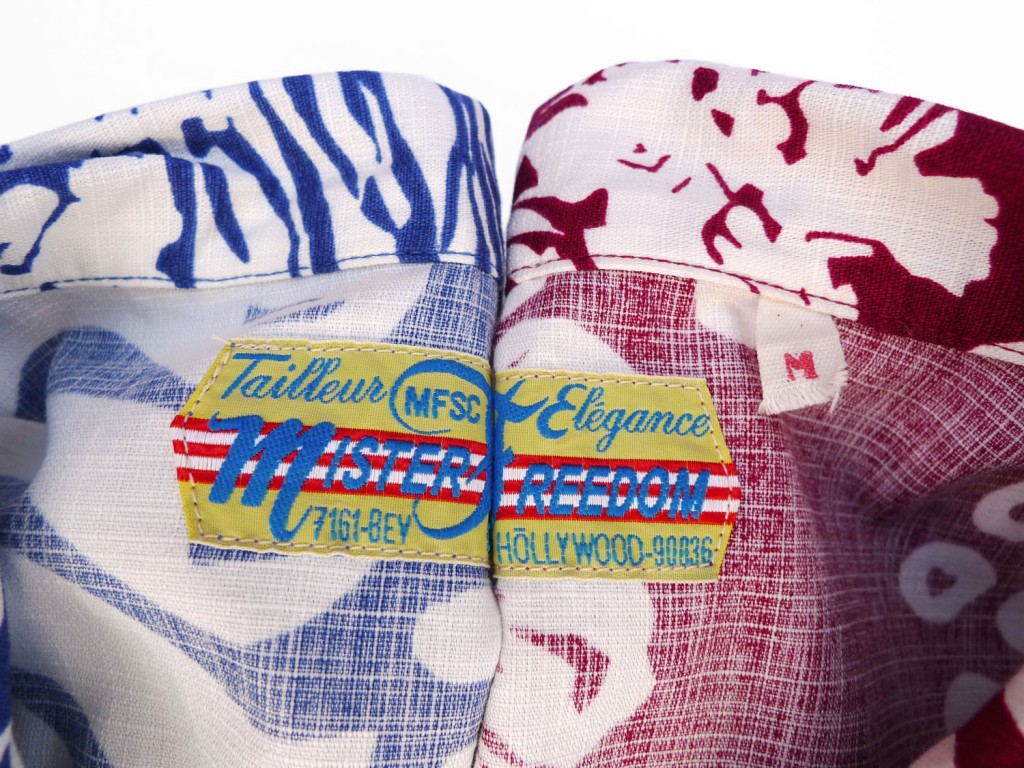
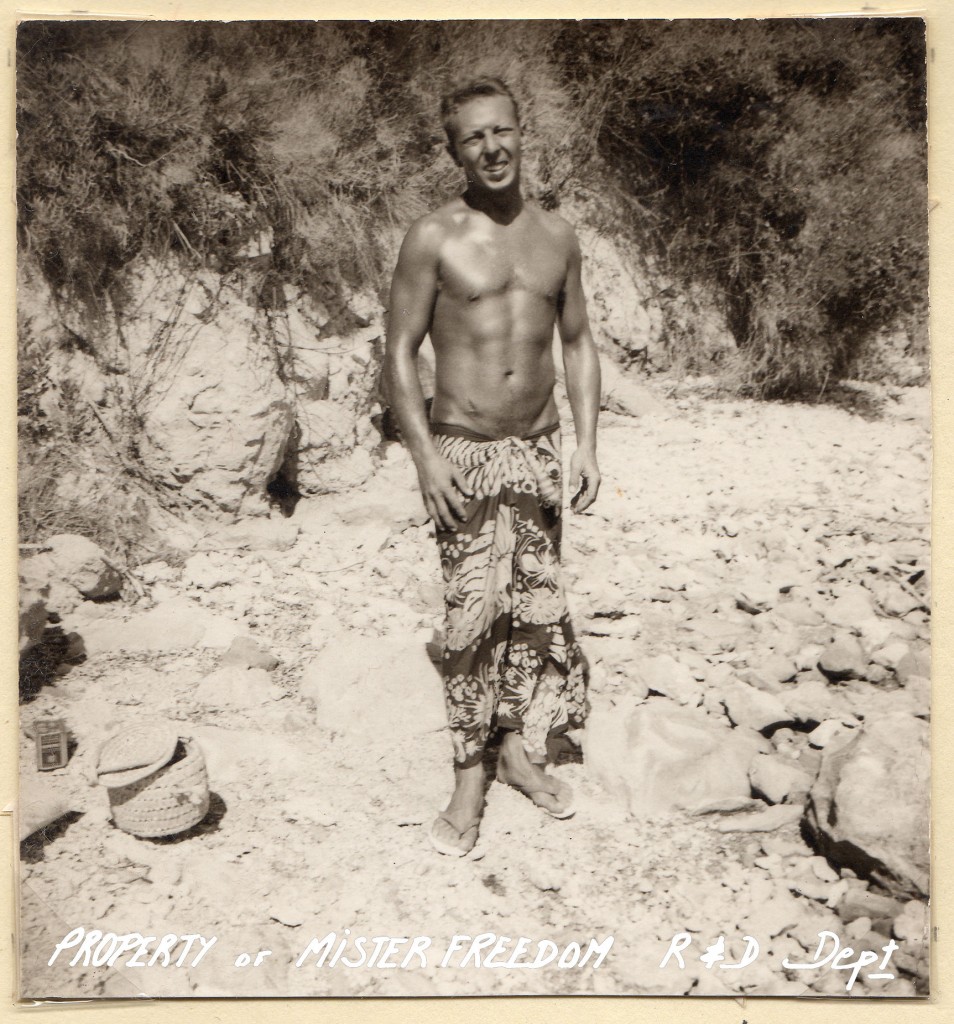 Who needs a shirt
-
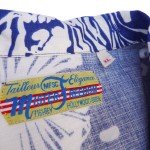
-
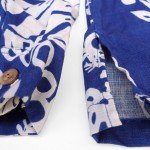
-
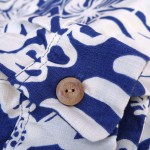
-
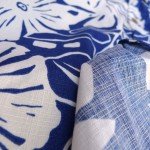
-
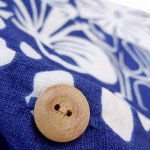
-
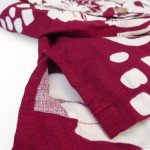
-

-
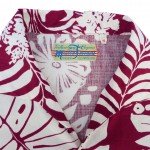
-
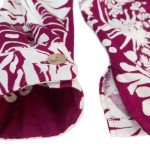
-
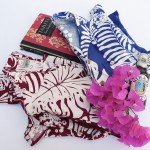
-
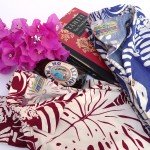
-
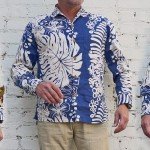
-
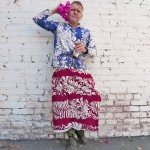
-
Celebrating Spring 2015
-

-
Drop the joystick and read a book
The “TAHITI” Shirt
“Saigon Cowboy” mfsc Spring 2015 Collection.
The short tale of this Mister Freedom® “Tahiti Shirt” involves the Club Med village of a sun-drenched Greek island in the late 1950’s, and a young adventurer half my age.
In the Club Méditerranée tradition of their early beach-front vacation villages, GOs (Gentils Organisateurs, the nice staff) were often issued printed pareos, in order to stand out and better entertain the GM (Gentils Membres, the nice vacationers). Nothing spells fun-in-the-sun like Polynesian prints do. For the French, Tahiti is the ultimate exotic-sounding escape from the daily grind, known as metro/boulot/dodo (commute/work/sleep) by the Parisians. For baguette lovers, anything associated with Tahiti means H.O.L.I.D.A.Y.S (no, not Johnny), save for the nuclear mushrooms of Mururoa, maybe.
-
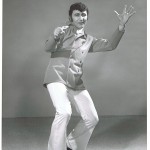
-
Johnny HOLIDAY, USA
-
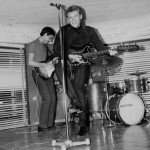
-
Johnny HALLYDAY, France
-
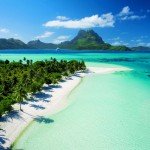
-
Bora Bora, anyone?
-

-
Baguette lover in Bora Bora (1995)
-
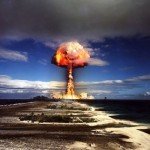
-
780 miles from Tahiti, Mururoa Atoll nuclear testing (1970)
In some villages, these Tahiti-style colorful cloth wraps were cut & sewn into aloha tops by local tailors or whoever handled the sewing machine best. I own two of these vintage shirts, had them for years. Mine originally belonged to a young fellow who had done a short stint as a GO in Greece, sometime in 1957. For just a few months, but long enough to improve on his water ski and social skills, and shake the djebel dust and smell of war off his mind.
The year prior, he had been enjoying twelve months of bushwhacking in green fatigues in the arid Algerian mountains. Military service was mandatory in France in 1956, and if you had just missed ‘l’Indo‘, you were about ripe for ‘l’Algérie‘.
A French colony since 1830, Algeria had been at war with France since 1954, claiming back its autonomy. For Algerian nationalists who had closely watched the demise of the old French colonial powers in Indochina culminating in the Diem Bien Phu firework finale, independence didn’t seem like utopia anymore. If their Vietnamese comrades had done it, so could they. But generations of French Algeria-born Pieds-Noirs, harkis, …, and a coalition of rogue generals, were not giving up that easy. Ensued the epic and gruesome Guerre d’Algérie (1954-1962), a very touchy topic to this day between both countries. Just quote Charles De Gaulle’s “Je vous ai compris” (I understood you) to a Pied-Noir, and watch what happens… For one planning to vacation in Algiers over the holidays, mentioning the OAS while strolling in the Casbah will also prove a great ice breaker to meet friendly locals.
But like they say, one front at a time, we’ll get back to this one some other day…
After getting his diploma in paréo-ironing from the Greeks, our playboy waterski instructor made his way back to Algeria in the following years. This time roaming the mighty Sahara desert as a drilling scout for the CPA (Compagnie des Pétroles d’Algérie, an oil extracting venture in North Africa). While at it, he managed to give a pretty Pied-noir gal his GO shirt, and my Mum a new last name…
None of the green fatigues, but two of the Club Med “Tahiti” shirts along with old photo albums happened to survive my Dad’s tumultuous expat life. He had nothing but contempt for hoarding, a ‘give-it-all-away’ modus operandi not shared by my Mum who often resulted to hiding things in order to find then again! I have an inclination to not collect anything myself, but I admit the few old relics he did not succeed in getting rid of back then are priceless to me today. Gérard Loiron, you are missed.
-
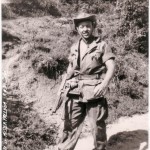
-
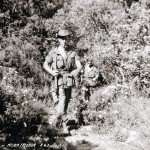
-
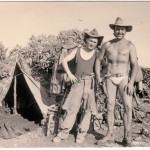
-
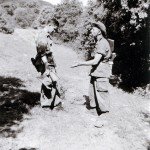
-
Kindly making a suggestion
-
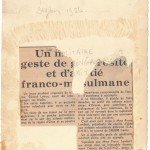
-
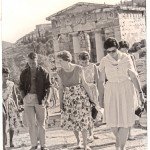
-
Ladies, please
-
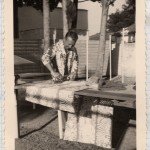
-
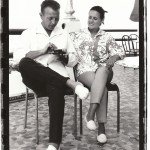
-
The Loiron’s
-

-
Original 1950’s Club Med shirts
-
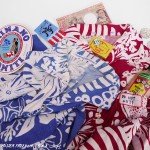
-
Discreet product placement
Both shirts were sent to our Sugar Cane Co friends in Japan and the fabric and prints analyzed. Hats off to the Toyo textile experts who reconstituted the entire panel artwork without taking the vintage samples apart. The floral design is non-symmetrical, as can be seen on the paréo-ironing session photo, and the motif repeat was very difficult to recreate for the Sun Surf® Graphic Dept. But it seems there is nothing they can’t do when it comes to Aloha-type shirts. Otsukaresama deshita.
The base textile of our Tahiti shirt is reminiscent, in texture, of those vintage kitschy 1960’s/70’s cotton Hawaiian shirts sometimes referred to as ‘bark cloth’. In the 1940’s/50’s, a thick and heavy version of that dobby weave cotton cloth had become a standard feature in most American households, in the form of printed curtains and upholstery fabric.
All those vintage iterations were modern renditions of the ancient Hawaiian kapa (or tapa in Tahitian, meaning ‘the beaten thing’), the natural wood pulp bark cloth of early traditional Polynesian attire that so impressed Captain James Cook back in 1769. “This stuff is awesome! Where to cop?” he reportedly said on his final voyage to the Pacific Islands, before being clubbed on the beach. But you might want to double-check on that.
Our “Tahiti Shirt” in barkcloth-like cotton fabric comes in two color options, coined by the MF® Linguistic Dept as Moana (meaning the mighty Ocean ie. the Big Blue) and Ura (meaning red), for the sole purpose of qualifying you as the most fluent individual in Tahitian language of your neighborhood at this second.
-
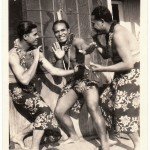
-
Doing the hula bop in pareo
-
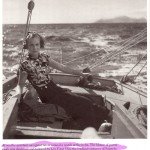
-
Pareo blouse by Lin Fung Chu, leading couturier of Papeete (1953)
-
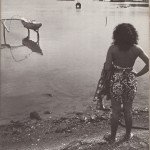
-
Tahiti ‘Voyage Through Paradise’ George T. Eggleston (1953)
At this point, a quite pertinent remark would be “how you planning to landfall that canoe in Saigon, son?“, in other words “The Nam?! Fun in the sun??!? wtf?!?!”
That’s when R&R comes in. No, not the devil’s music, I mean Rest & Recreation.
During their 12 or 13-month Vietnam tour, American soldiers could take a one-time leave out of Vietnam, for a maximum of 30 days. Jungle fatigues were dropped at the departure air base, khakis slipped on, and civvy clothing often rented at the destination. Popular escapes were Hawaii, Sydney, Bangkok, Hong Kong… from where souvenirs and loads of crusty epic stories were brought back.
Additionally, shorter in-country R&R were awarded to wary grunts with an urgent need to go cool off away from Agent Orange and Victor Charlie for a few days. The South China Sea waters of Cam Ranh Bay, Vung Tau, and the famed Da Nang China Beach saw many a sunburnt GIs come and go during the 10 years of the Vietnam war. Some days, those beaches almost looked like beaches at home, save for the M-16 of the US Marine lifeguard on tower duty, or the occasional bandages from hospital ships washing ashore. Sorry ’bout that.
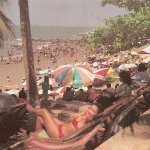 Vung Tau Beach R&R (1966) Cinephiles will also notice that the Mister Freedom® “Tahiti shirt” is a nod to the famous M*A*S*H* war comedy film and TV series, which featured characters (“Trapper John” or “Hawkeye”) flashing a floral shirt in the context of a Mobile Army Surgical Hospital. A wardrobe oxymoron, intended to highlights the level of gallows humor necessary in the field to help deal with the absurdity and brutality of war.
“... it was so far out, you couldn’t blame anybody for believing anything. Guys dressed up in batman fetishes, I saw a whole squad like that, it gave them a kind of dumb esprit. Guys stuck the ace of spades in their helmet bands, they picked relics off of an enemy they’d killed, a little transfer of power; they carried around five pound bibles from home, crosses, St. Christophers, Mezuzahs, locks of hair, girlfriends’ underwear, snaps of their families, their wives, their dogs, their cows, their cars, pictures of John Kennedy, Lyndon Johnson, Martin Luther King, Huey Newton, the Pope, Che Guevara, The Beatles, Jimi Hendrix, wiggier than cargo cultists.”
(Excerpt from Michael Herr’s ‘Dispatches‘, correspondent for Esquire Magazine in Vietnam, 1967-1969.)
Anyways, the “Tahiti shirt” was designed in California by Mister Freedom® and manufactured in Japan in collaboration with Sugar Cane Co.
SPECS:
FABRIC:
100% cotton ‘bark cloth’ like dobby fabric base. 1950’s Polynesian floral design print replica. Fabric milled in Japan.
DETAILS:
* Original mfsc updated pattern, inspired by authentic 1950’s local-made tourist attire.
* Long sleeve.
* French style col requin (shark fin shape collar)
* Genuine coconut shell buttons.
* Matching single chest pocket.
* No back yoke.
* Side slits.
* Flat-felled seam chainstitch construction, narrow folder.
* High count 100% cotton tonal stitching.
* Limited edition.
* Made in Japan.
SIZING/FIT
The “Tahiti” shirt comes raw/unwashed and will shrink to tagged size after an original cold soak/line dry.
If you are a Medium in mfsc shirting, you are a Medium in this shirt.
We recommend an initial cold soak, spin dry and line dry. Please refer to sizing chart for measurements reflecting this method.
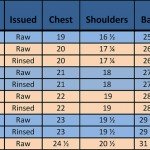
CARE:
Launder when hygiene dictates and common sense prevails.
Machine wash. Cold water, gentle cycle, eco-friendly mild detergent and line dry.
Available RAW/unwashed.
SIZES:
Small
Medium
Large
X-Large
XX-Large
RETAIL $269.95
Soon available from www.misterfreedom.com
Email sales@misterfreedom.com or call 323-653-2014 with any questions unanswered above.
Maururu for your support 🙂
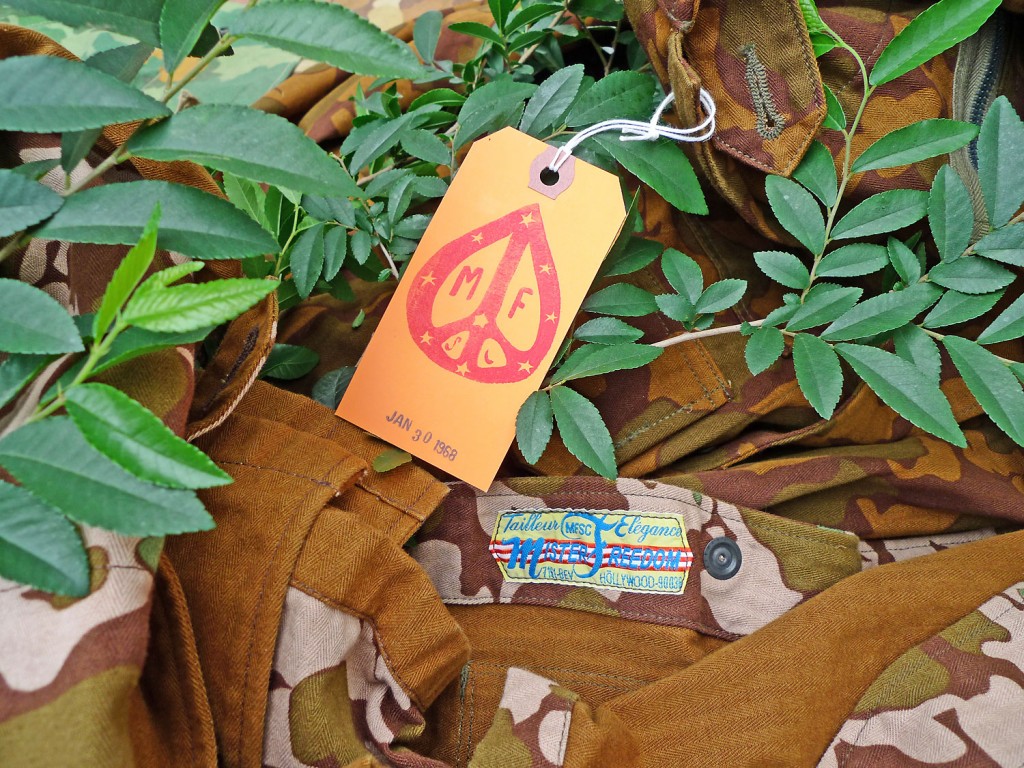
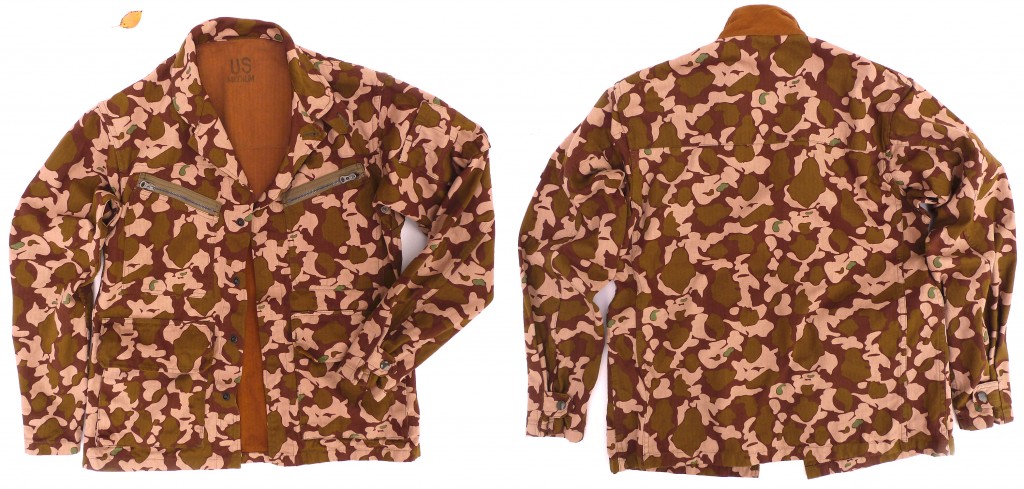
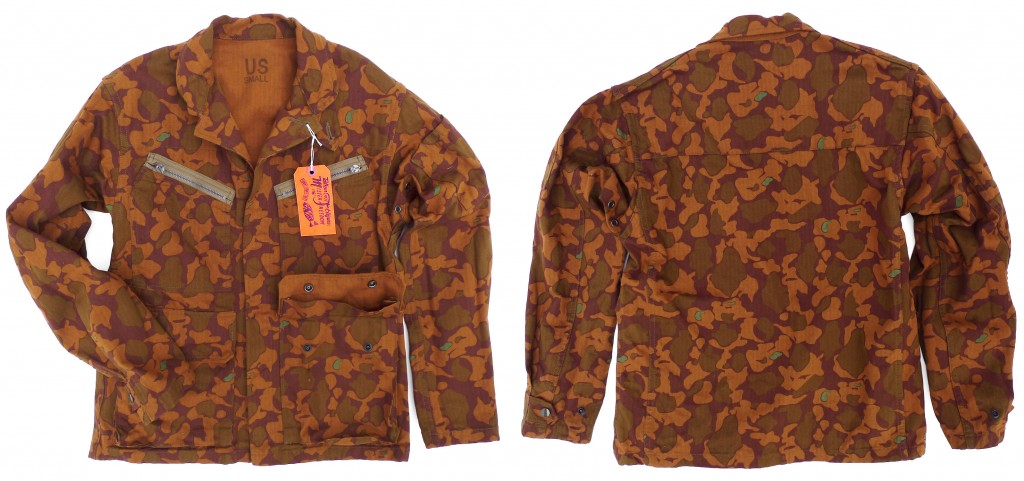 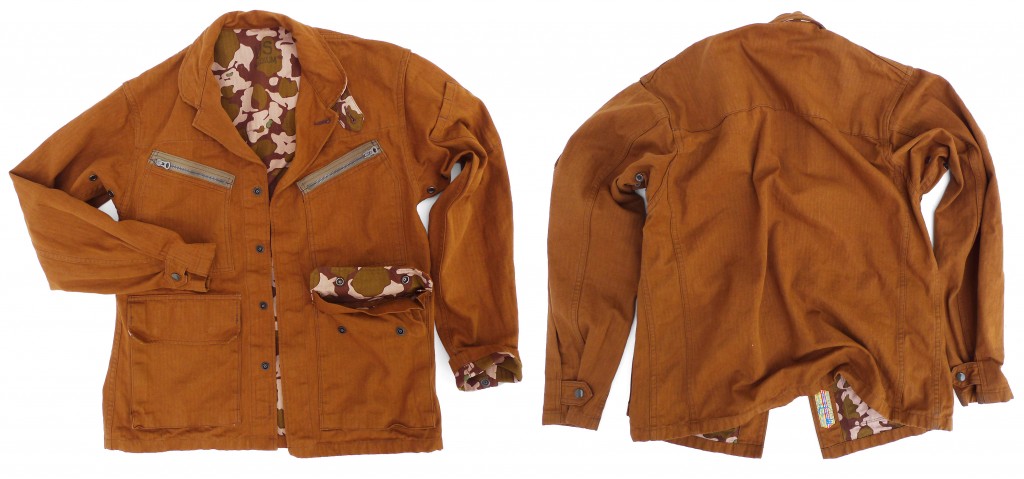
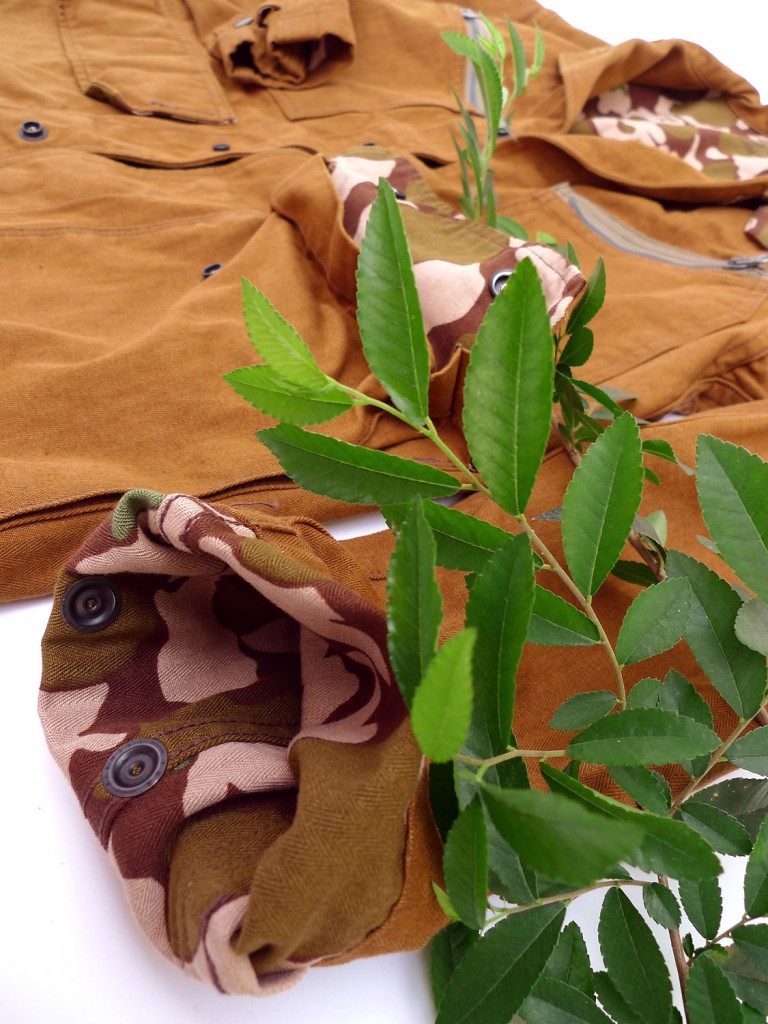
Evac Jak, Experimental Camouflage
Mister Freedom® “Saigon Cowboy” Spring 2015
After an Homeric attempt at an introduction of both our intentions and the background of our Spring 2015 “Saigon Cowboy” concept collection, here comes the time to actually unleash its first chapter. Straight off the steamy jungles where the panthera tigris, majestic beast of the night, roamed free. Until…
…whomp-whomp-whomp-WHOMP-WHOMP-WHOMP…
(skies fill with green UH-1s above the canopy, “Ride Of The Valkyries” plays)
It’s show time… sit back and cringe.
It is a documented ancient tradition for warriors to adorn themselves with the furry hides of ferocious hunted creatures, in order to appropriate and hog specific powers from the animal kingdom.
This practice seems to have extended to modern warriors by way of printed cloth known as camo. From the leopard-print cowboy hats of some US advisors in Vietnam to the flashy cheetah-print fatigues of the General Mobutu’s Armed Forces of Zaire in the 1970’s, it can be said that there is no end to human creativity in the concealment business.
To quote the New York Times in a camouflage-related piece back in 1917, “It is a wonderful opportunity, this game of hokus-pokus“.
Nothing spells human ingenuity like painted zebra stripes on a donkey or battleship to fool the enemy.
-
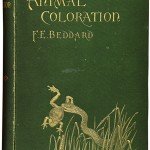
-
Animal Coloration, Frank Evers (1892)
-
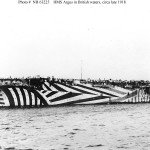
-
Dazzle camo HMS Argus (1918)
-
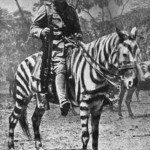
-
Camo pony, British Cavalry WW1 East Africa
-
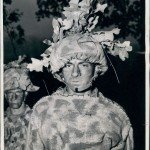
-
Hessian Frogskin (1943?)
-
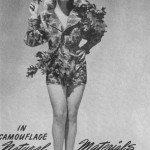
-
Chili Williams (1943) Ewing Krainin
-
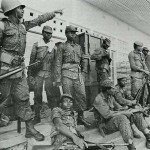
-
Armed Forces of Zaire camouflage (1977)
-
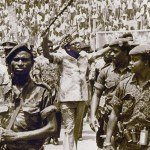
-
Mobutu (1974) Cheetah camo
-
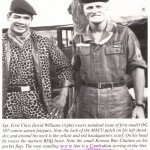
-
Leopard Camo (1964) David Williams. Courtesy Paul W. Miraldi, Schiffer Books
-
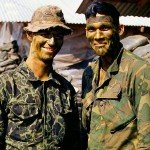
-
101st Airborne ROK and ERDL camo (1969)
-
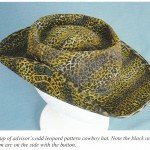
-
American advisor cowboy hat in Vietnam (1959) Courtesy Paul W. Miraldi, Schiffer Books
-
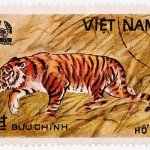
-
Panthera tigris, courtesy Ivan Vdovin
-
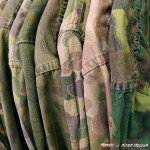
-
Camo coma at MF® (2015)
For the past 100 years or so, commercial or military camouflage has continued to appear in all kinds of shapes, colors, forms, at various levels of justification. See the “Disruptive Pattern Material” brick (ISBN-13: 978-1554070114) for a potential camo coma.
In the printed camouflage family, the military ‘Experimental’ group is of particular interest to me. It features patterns painstakingly designed by boards of experts that never made it to standard issue status, from either lack of interest, failure of the field tests, budget issues, fluctuations in theater of deployment according to where the evil enemy of the month hides, etc…
Specimens of obscure patterns are sporadically unearthed and sometimes shared by collectors, such as this handsome “MacLaren” for instance. Some patterns are only known to be in existence from a brief feature on an official publication or rare field test photo set. Whether one-of-a-kind individually hand-painted for a specific mission, or produced in small batch/tested in combat/pulled as inconclusive, there’s gotta be some interesting stories about these experimental camouflage pattern in the Fort Belvoir archives (US military’s headquarters for camouflage R&D in Virginia), or the Natick Labs file cabinets…
-

-
Soldier-Artist sketching at Fort Belvoir (1942)
-
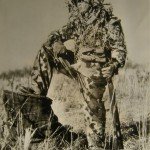
-
Experimental MacLaren Camo (1943)
-
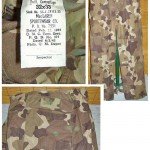
-
MacLaren Camo (1944) Courtesy US Militaria Forum (Hzamar)
-
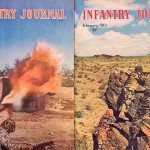
-
Infantry Journal (1944) featuring Exp Camo
-
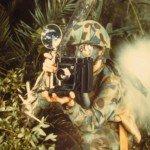
-
Combat Photographer WW2
-
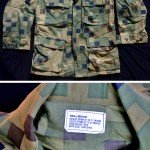
-
Experimental Camo (1970s)
In an effort by the Clothing Division of the Office of the Military Planning Division to financially recover part of the cost of R&D, it is plausible to imagine that rolls of obsolete experimental camouflage fabric ended up being sold to jobbers or Army/Navy surplus stores, eventually cut & sewn into tarps, hunting clothes and civvy fatigues. Obscure sample runs and seconds from the stock pile of a fabric-printing mil-specs contractor could also surface out of nowhere after liquidation…
For the Mister Freedom® Spring 2015 “Saigon Cowboy” collection, I thought of temporarily playing camoufleur. But how does one ‘invent’ a camouflage? Relieved of the overwhelming pressure of having to help save or take lives, I was still shooting for something that would look more legit than foofoo. Besides the early realization that most assignments are better left to professionals, off we were on our merry way to come up with the first ever ‘original’ MF® ‘flage! Oh boy…
As most camouflage patterns are an interpretation of a predecessor (the 1980’s Woodland is an evolution of the 1960’s ERDL leaf pattern), I felt less shame borrowing the famous amoeba shapes of the P1942 “Frog Skin” we had used for the Map Shirt of our Sea Hunt days . We opted for the same sturdy 100% cotton HBT white base fabric however, the same painstaking rotary-print technique (not computer printed or over-dyed), and the same concept of a reversible fabric.
The fun part was selecting the colors… and determining where exactly the MacLaren-inspired sparse lime green amoebas looked best.
After going back for weeeeeks to the drafting table, with color swatches and unsatisfying protos, going bananas and obsessing about visual contrasts & blends, face & reverse, we managed to settle on ONE pattern, in several options.
If our approach is an obvious nod to the Beach & Jungle sides of 40’s USMC reversible Frog Skin gear, the MF® Exp. camo combines camouflage with a simple solid side. The solid side cachou color is a reference to the caramel-like color typical of 1930’s French military canvas gear. Please note that if our fabric is technically reversible, the resulting garments are not.
For confusion sake, and to make sure everyone feels as in-the-fog as we do, here is a list of MF® Experimental ‘flage options available this season (please note that, depending on distribution in a specific Country, not all options are available). The face/reverse options are:
A) LoLand out (jungle, darker)/cachou in.
B) HiLand out (arid terrain, lighter)/cachou in.
C) Cachou out/HiLand in.
Wearing an early proto jacket of the MF® LoLand camo the other day at the Rosebowl flea market, it was quite satisfying to be asked by a puzzled seasoned militaria collector “What Country is that?”… Made my day.
The MF® Exp. camo is featured on two pieces of our “Saigon Cowboy” Spring 2015 collection.
* The Evac Jak.
* The Utes.
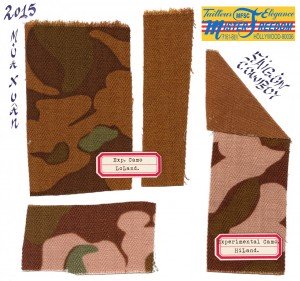 MF® Experimental Camouflage Spring 2015
First to hit the LZ this season is the “Evac Jak”, a snap closure cotton jacket.
For the inclined, a bit of approximative History and semantics follows. Read or fast-forward, but as always make sure not to quote me on anything that requires exactitude…
The name we picked is a reference to MEDEVAC, the call sign for helicopter ambulance and crew in charge of medical evacuation during the Vietnam conflict. For the 1st CAV who forged its own, a MEDEVAC crew consisted of an Aircraft Commander, Co-Pilot, Crew Chief, Door Gunner and a Medic. Defying the odds of survival by most likely landing in a hot zone, these men gave their lives to save others’. Statistics have it that, among the ranks of American soldiers fighting in Vietnam, “nearly 98% of those wounded in action were evacuated from the battlefield alive.”
That courage qualified the dustoff crews as a trooper’s best friend on the battlefield. For the wounded soldier, the sound of that Huey coming to the rescue was sweet & sour music, the sight of that flying Red Cross meant a ticket back ‘in the world’.
In a war that dragged over a decade, in-the-field gallantry could only be sustained by the relative reassurance of knowing someone was coming to lift you out of the muck on time. Countless accounts of courage and sacrifices from those MEDEVAC and DUSTOFF crews have been published.
Similarly, the NVA (=the communist North Vietnamese Army, China’s protégé opposing the South Vietnamese Army, aka ARVN, America’s protégé… just look it up) went through great length to carry their fallen away from the battlefield for proper burial ceremonies. Faced with fighting the most powerful Nation on Earth, NVA and VC troops needed the guarantee of a better afterlife to accomplish the impossible…
-
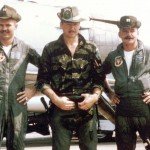
-
USAF pilots Bruce Holmes, Will Koenitzer, William Barthelmas (circa 1965)
-
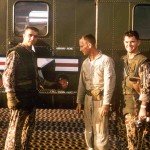
-
Vietnam Marine Squadron (1963) Courtesy Jack Ubel
-
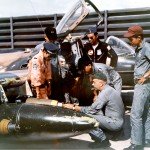
-
VNAF pilots and USAF instructor (1960s)
Back to our fiction…
Because a specific helo pilot-issued jacket didn’t seem to happen during the Vietnam conflict, we decided to come up with one. The style of our “Saigon Cowboy” Evac Jak is inspired by 1960’s US Air Force flight suits, 1950’s French army field jackets and Vietnam era flyboy gear, with an in country-made flair. Pilots and flight crews occasionally had custom local-made gear to replace the standard Gov’t issued garb, as period photography hints. Camouflage appealed to some airmen, should they themselves get to experience waiting for a dustoff… The one-piece flight suit also proved unpractical and some pilots, fixed wing or rotary, opted for the jacket (shirt)/pants combo.
To accentuate the local-made meets custom Saigon tailor ‘vibe’, we have ink-stamped sizing in a manner reminiscent of CISO-supplied military garments. The “US” stood for sizing following American standards, as opposed to the “A” stamp differentiating Asian standards garments. See the book “Tiger Patterns” (ISBN-10: 0764307568) for more on that.
For the anecdote-oriented few, the idea behind our MF® “mfsc Tailleur” woven label being somewhat concealed on this jacket (bottom of the inside front panel, and not in its expected back yoke position), is to highlight the contrast between name-branding and the signature of a local tailor. Oddly enough, in the past, legit tailors tended to sign their works in a conspicuous spot. Famous Brands today do it on the outside, with voluminous logos.
The Evac Jak is designed in California by Mister Freedom® and manufactured in Japan by Sugar Cane Co.
SPECS
FABRIC:
Somewhat original Mister Freedom® camo pattern, double-side rotary screen printed (one side solid, one side camo), white 100% cotton Herringbone Twill (HBT) fabric base.
Fabric milled and printed in Japan.
DETAILS:
* Inspired by vintage USAF flight suits and French military field jackets.
* Un-lined, no overlock seams.
* ‘Bat sleeves’ arm pattern.
* Flight suit typical slanted chest pockets with mil-specs replica 1950’s US Air Force metal “CROWN” zippers.
* Large lower cargo-type pocket.
* Concealed snap front closure.
* Arm pen pockets.
* Wrist snap cinch tabs.
* Round collar with removable chin-strap
* Underarm mesh screen eyelets.
* Intricate front/rear shoulder yoke.
* Flat felled seam construction, 100% cotton thread.
* Non-reversible.
* Made in Japan.
SIZING/FIT
This garment comes raw/unwashed and will shrink to tagged size after an original cold soak/line dry. Further shrinkage to be expected with the use of hot water and heat dryer.
All MF® Exp. Camo fabric options will shrink the same.
If you are a Medium (38) in mfsc jackets, you are a Medium in the Evac Jak.
Please refer to sizing chart for measurements reflecting a 30mn cold soak no agitation/light machine dry.
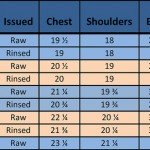
CARE:
Launder when hygiene dictates and common sense prevails.
Machine wash. Cold water, gentle cycle, eco-friendly mild detergent and line dry. We recommend turning garments inside out to avoid marbling of the fabric during the washing cycles.
Because the base HBT fabric is white before being printed, toning down of colors will naturally occur. This fading should not be considered a quest nor a defect, only the natural consequence of the wash/wear process over the years.
Available RAW/unwashed
SIZES:
Small
Medium
Large
X-Large
XX-Large
RETAIL $429.95
Available from www.misterfreedom.com, fine retailers around the World, and our dusty Los Angeles brick & mortar store.
Email sales@misterfreedom.com or call 323-653-2014 with any questions unanswered above, like what happened to D) Cachou out/LoLand in???!
Thank you for your support
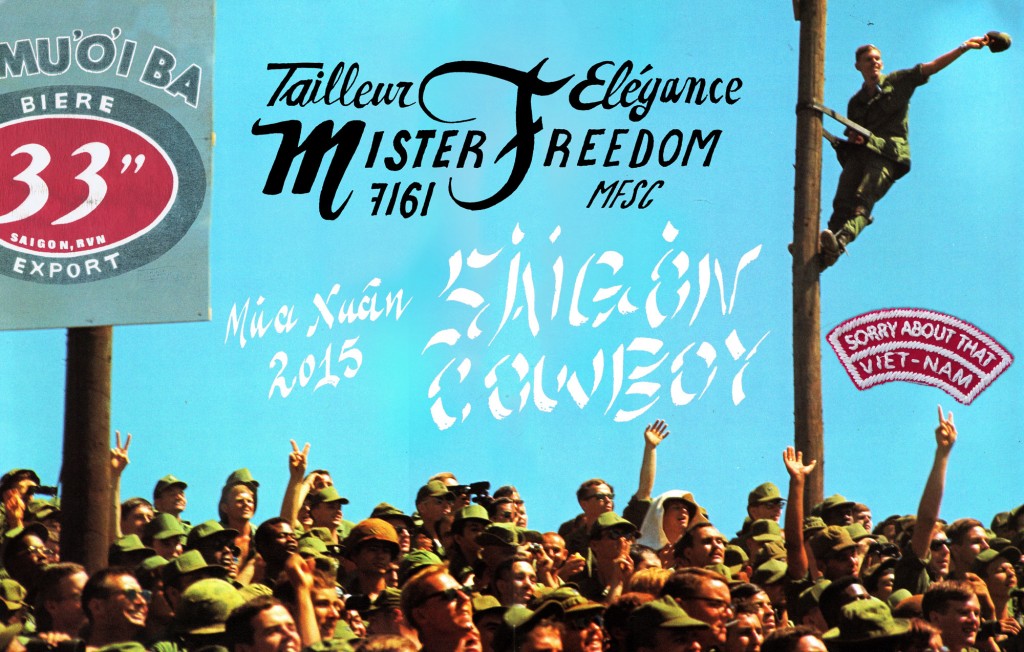 (Photo Tim Page ©1983, Bob Hope Show, Long Binh amphitheater, 1966)
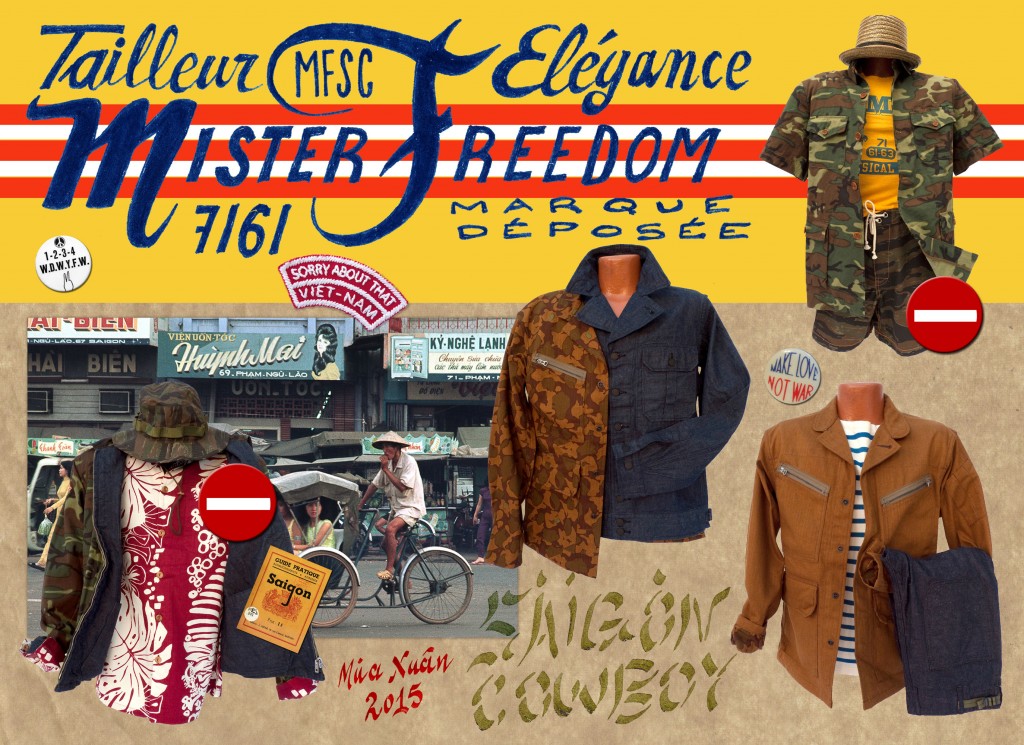 Considered offensive material removed 01/08/2015
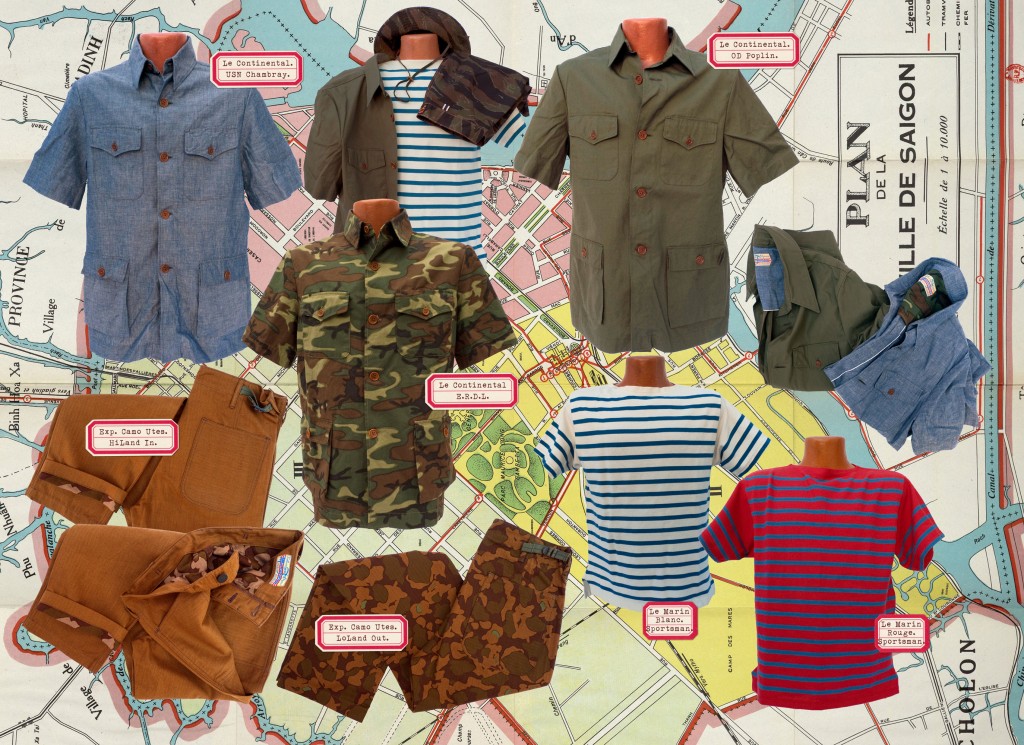
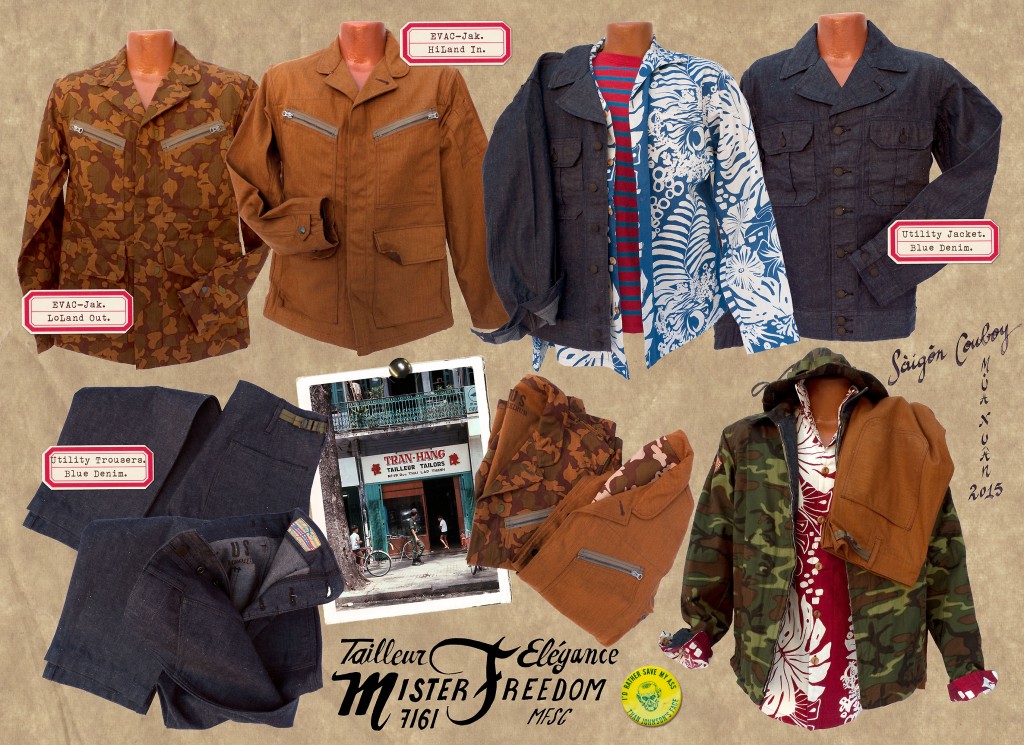
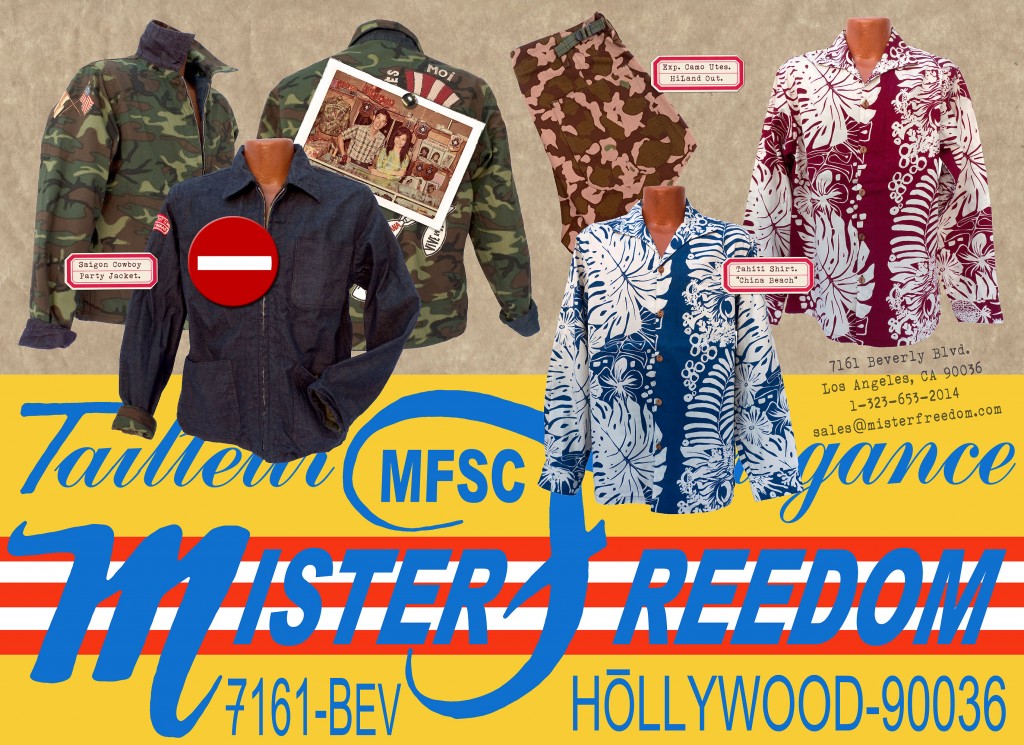 Considered offensive material removed 01/08/2015
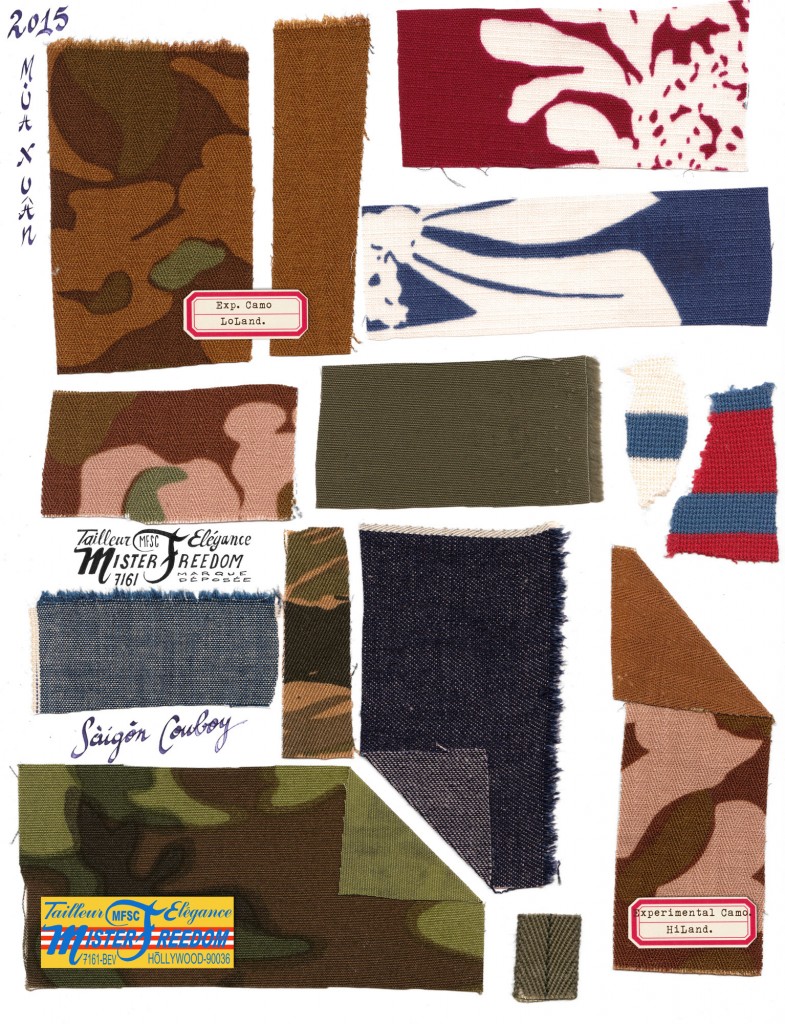
“SAIGON COWBOY”
Spring 2015 mfsc Collection
The obscure title “Saigon Cowboy” could mean many things (camera snatchers on cyclos, flamboyant pimps…) but in our case refers to a colorful Vietnam War era US military slang expression. According to several period accounts, it was a derogatory term used to describe ‘in-country’ personnel, along with freshly flown-in reporters from the eager international press, stationed away from the front line. Saigon was safer than the boonies. The real danger, ‘where the metal meets the meat‘, was beyond the tree line, in the elephant grass, in the jungle, in the rice paddies… Garrisoned in the Vietnamese southern capital, a “Saigon Cowboy” looked the part, sipped drinks at the Continental, all clad in custom-made jungle fatigues or safari gear, pockets everywhere, but never saw real combat. 1960’s military expressions like chairborne commando or garitrooper carry a similar, easier to visualize meaning.
-
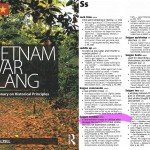
-
“Vietnam War Slang” Tom Dalzell (2014) courtesy Routledge
-
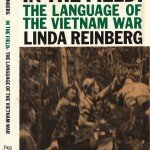
-
“In The Field” Linda Reinberg (1991)
But let’s rewind a bit…
Some of you are by now familiar with how I use slices of approximative History as backdrops of the Mister Freedom® capsule collections. Trends are of no interest to me, fads not inspiring, and that market well cornered anyways.
I also have an urge, at times, to rationalize my involvement with the fashion circus by mentioning, to who chooses to hear it, issues pertaining to the garment industry and rarely addressed by fashion media thriving on advertisers.
You know my broken record: “Think more, buy less“, impact of fashion consumerism, absurdity of garment factory distressing, cost of goods vs. bargains, Country Of Origin, ethics in garment manufacturing, payola in some product-reviewing media, etc…
I do know my limits however, and stick to the occasional whining. The real task of changing things on the ground is better left handled by professionals who, hopefully, know what they’re doing: sincere volunteers, no-nonsense environmental activists, local labor laws authorities, apolitical humanitarian organizations (MSF, Red Cross, Clean Clothes Campaign…)
In mentioning serious issues, I usually strive to ‘keep it light’, PC or not. The International news feed is depressing enough. Sugar coating comes in handy as you don’t catch flies with vinegar. At the risk of aggravating mobs of righteous keyboard cowboys, I believe goofing around about grave issues tends to wake up lethargic brains, and ultimately does more good than harm.
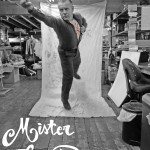 Looks like another mission for Super Zero… Sometime in 2013, while doing research on our “Sea Hunt” venture, I felt the need to, go figure, highlight the absurdity of war. Specifically the avoidable kind. Much of the Mister Freedom® catalog shows all the respect I have towards the Men and Women of the Armed Forces. This respect will remain unchanged, family heritage and personal views. But like most thinking adults I know, I also hate the reality of war and find the term cannon fodder physically sickening.
I wanted to talk about that duality via a clothing collection…
World War II (1939-1945, if you ask the French), a source of inspiration for designers for years, was too remote. It was in black & white, had ‘glamour’ attached to it, had celebrated heroes, and benefited from a somewhat simple ‘good guys vs. bad guys’ scenario.
Ask the person next to you about the Korean War (1950-1953) and you’ll realize that, unless you fought it, it pretty much went under the radar.
By contrast, the Vietnam War (1965-1975… officially) was a showstopper. Along with its harbinger the Guerre d’Indochine (1946-1954), both felt harder to rationalize, comprehend and legitimize as they dragged on. Whether actively involved or remotely witnessing it uncensored on live TV, everyone had an opinion about it. From the fall of Dien Bien Phu in 1954 to the fall of Saigon in 1975, the Vietnam War (known as the American War to the Vietnamese) was to split public opinion worldwide, and still confuses people to this day.
“No event in American History is more misunderstood than the Vietnam War. It was misreported then, and it is misremembered now.”, reflected Richard Nixon in 1985.
It seems there is no easy way to summarize that conflict without falling into stereotypes, or getting in trouble with either of the “1,2,3,4 WDWYFW” crowd or the “Zip it hippie” bunch.
Whichever side of the fence you stand on, high command learned to mix the following ingredients, in random order, to guarantee the perfect ‘soup sandwich’, aka ‘goat rope‘:
Cold war, defunct dynasties, obsolete colonial hierarchy, religious rivalries, SOG recon teams, Uncle Sam, Uncle Ho, Chairman “uproar in the East, strike in the West” Mao, 17th parallel, 317ème section, 1st Lady Madame “barbecue” Nhu, crooked political chess board, puppet regime, coups and counter-coups, quiet American spooks, corruption, Russian advisors in black fatigues, American advisors in black pajamas, Laos and Cambodia black ops, red scare, the Corsican mafia, Air America, Victor Charlie, the Big Red One, Peace signs, Kim Phuc, monsoons, burning monks, stringers, “Five O’Clock follies“, jungle cadres, Search & Destroy, Bob Hope, Hanoi Jane, tunnel rats, freedom birds, punji sticks, B-52’s, montagnards, green berets, bouncing bettys, go-go dancers, Jimmy Hendrix, sappers, imperialism, gallantry, ranch hands, hippies, napalm, Pax Americana, General Giap, Rolling Thunder, Martin Luther King, war groupies, draft dodgers, grafters, incompetence, attrition, Pacification, Vietnamisation, patriotism, fragging, profiteering, agent orange, purple haze, television, heroism, utter confusion, Saigon tea, bennies and Rock’n’Roll, five consecutive US Presidencies…
A winning recipe for a ten-season HBO show today, but a sure promise to not reconcile the interests of diametrically-opposed cultures back then, losing many hearts and minds in the process.
What truly went on in South East Asia during those tragic somber years relies on who lived to tell, but will mostly depend on who you ask (or read). Some will replay each battle, from Ap Bac to Khe Sanh and explain how things could have turned. But that’s not the point.
What most agree on is that the quagmire resulted in well over 3 million casualties globally. And more PTSD than medical knowledge could handle. Lucky enough to not be one of the 58,002 American casualties or that war, returning Namvets realized how ‘popular’ they were back ‘in the World’. In Vietnam, ghosts of victims are still haunting the living today, as it is believed that violent death condemns the soul to endless wanderings.
No one will ever forget, some never forgive…
Heavy stuff.
Well, the topic hardly sounded like a good idea for a conversation at a Vietnamese, Cambodian, Laotian, American, French or Chinese family dinner table. Let alone a sound choice as the backdrop for a 2015 clothing collection.
All the signs flashed Charlie Foxtrot… KEEP OUT!!! Better stay safe, focus instead on fashionable dilemmas such as length of chin straps, facial hair grooming, perfect denim washes, ultimate length for selfie sticks, etc… I did consider backtracking last year, go PC, drawing unicorns and rainbows instead of experimental camouflage.
But I was too far gone, somewhat hypnotized by what went on in Vietnam, how and why, mesmerized by the subculture it created, then and now. The thing about the past is that it did happen, right or wrong, and whether we like it or not. It seems more constructive to me to learn from it, rather than sweeping it under the rug. Studying the past might not prevent History from repeating itself, but could help anticipate what’s incoming after choosing to invade distant countries, eventually putting the old adage ‘only the dead have seen the end of war‘ to rest.
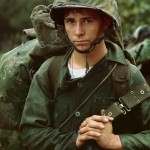 Yes. You do that. So Nam it was, and I’ll let the US Department of Defense handle the complaints for those whose ON/OFF switch malfunctions.
I had to dig deeper. Looked up obscure-sounding acronyms, ARVN, MACV-SOG, CISO, LRRPs, PSYOP… each opening squeaky doors leading to a disturbing fairly recent past. For a well-documented background, there were the 7000 page-long “Pentagon Papers“, declassified since 2011. In order to not completely lose my mind in the R&D process, I passed. I limited my research to countless radio show podcasts, period photos, recorded interviews, books such as Neil Sheehan “A Bright Shining Lie” (1988), Tim O’Brien “The Things They Carry” (1990), and Michael Herr cultish “Dispatches” (1977) to name a few. Several film documentaries also helped me get a perspective, and provided plenty material for insomnia and confusion. Some were just pure chronological footage, some took different perspectives. “Sir No Sir” (2005), “FTA” (1972), “In The Year of the Pig” (1968), “La Section Anderson” (1966), “Vietnam’s Unseen War – Pictures from the Other Side” (2002), “The Quiet Mutiny” (1970), “Hearts and Minds” (1974),… all the way to the recent “Unclaimed” (2013). Besides the famous usual suspects, I kind of avoided Hollywood on this one, although I did take a break with, beware, joke in-coming, “Tropic Thunder”.
It quickly became clear to me after a few pages of Tim Page or Larry Burrows photography books that the Vietnam war was no John Wayne’s “Green Berets” borderline-glamorous depiction. Interestingly, vets accounts have even blamed that movie for getting grunts shot in Vietnam. Eager boots in starched fatigues dropped ‘in country’ would go Hollywood-style gung-ho at times, flak jacket off, especially when an AP camera was filming… But there was just no take two with live rounds, sorry ’bout that.
I realized I was just making civvy clothes here, not Kurtz’ wardrobe, no GI gear replicas either. The essence of the period, place and events felt complicated to interpret into wearable pieces. The gruesome reality of that war didn’t help, so I had to go somewhat of the “M*A*S*H” route rather than the “Hamburger Hill” end of the spectrum. To put the collection together, I opted for gallows humor and its risks, crude 1960’s war slang lexicon, high doses of fiction and lots of imagination, as I was never there…
Magically, the concept appeared all summed up in this quote from Michael Herr, seasoned war correspondent for Esquire Magazine in Vietnam (1967-1969) depicting a newbie reporter eager for some in-country scoops:
“... he was dressed in one of those jungle-hell leisure suits that the tailors on Tu Do were getting rich cranking out, with enough flaps and slots and cargo pockets to carry supplies for a squad…”
(“Dispatches”, 1977)
-
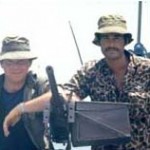
-
War corespondants Michael Herr (left) and Sean Flynn (circa 1968)
-
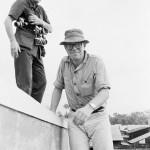
-
Michael Herr (right) was NOT talking about Larry Burrows (left) in that quote.
-

-
Dispatches Michael Herr (1977)
This Mister Freedom® “Saigon Cowboy” capsule collection is not a mere fashion statement. It is not intended to be controversial for the sake of it. It is not shocking for the show. It is not an attempt at offending war veterans, communities, the People of Vietnam or any nationals of countries involved or affected by that conflict. It is not meant to revive bygone or dormant animosities, nor to create new ones. It is not made to raise eyebrows but rather open a few eyes. The historical backdrop of the Vietnam war is used as the premise for an individual reflection about the absurdity of war and the age-old well-documented duality of Man.
When released, around April 2015, each piece of the collection will come with a ‘manual’, ie. a brief introduction post with a few links to click on, for those who have the patience.
Our “Saigon Cowboy” experience will be out of the comfort zone for some. But if it plants just one thought-provoking seed out there, then the risk was worth taking.
There it is.
Peace, get some.
Christophe Loiron,
Mister Freedom®
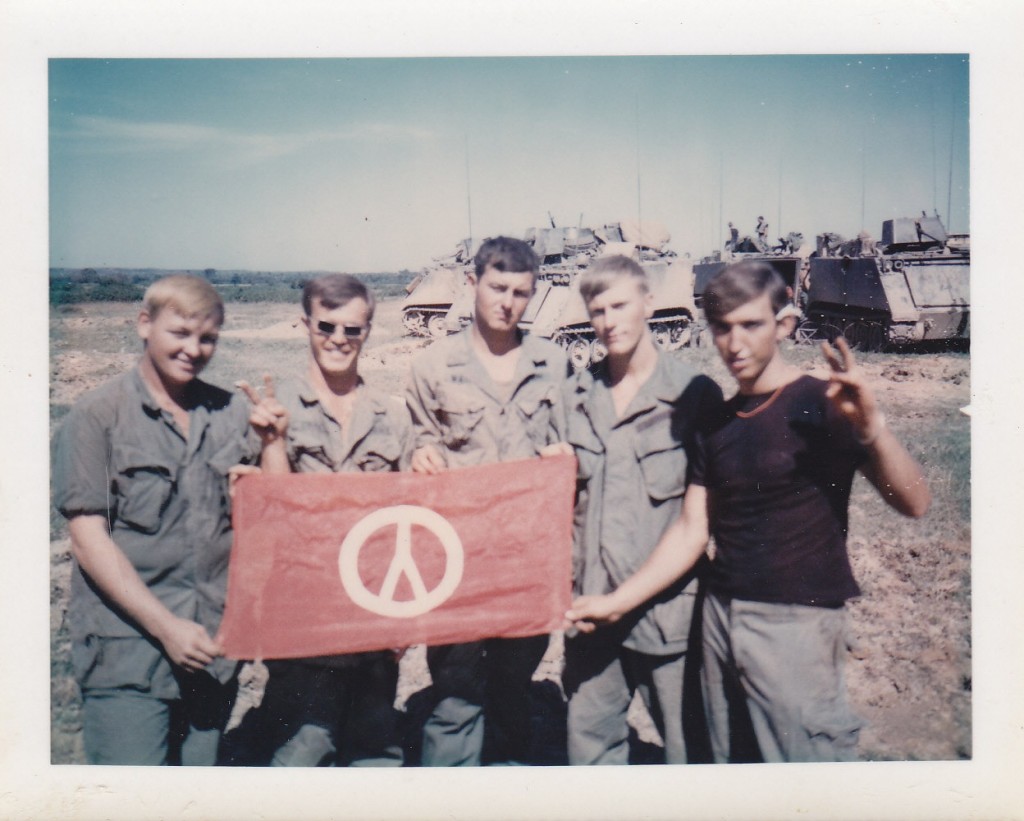 Mercedes-Benz or Peace sign? Photo courtesy Rich “Jonesy” Jones 1969-70

|







